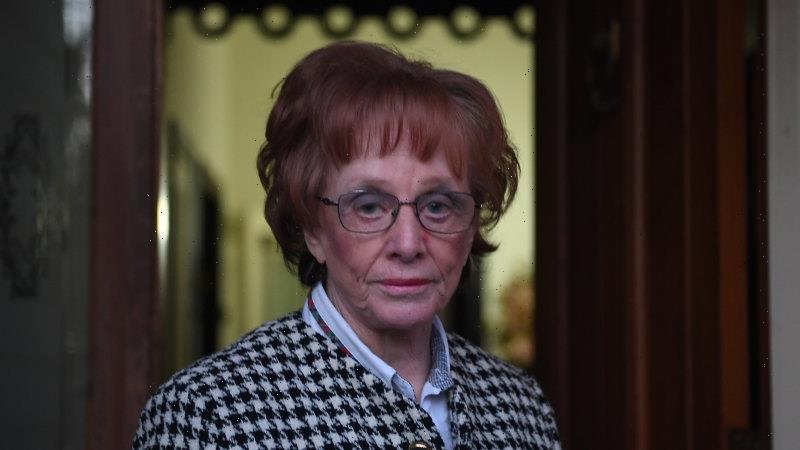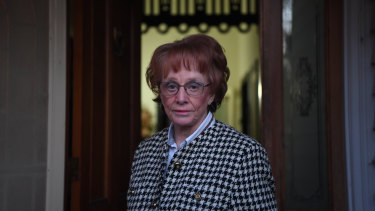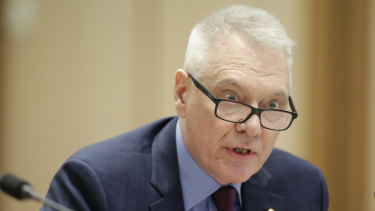For our free coronavirus pandemic coverage, learn more here.
Residents in Gippsland have emerged as the least vaccinated for COVID-19 at the state’s mass immunisation centres, according to new figures from the Andrews government which give the first major snapshot of where Victorians are getting jabbed.
But the figures only tell the story of the state-run vaccination program because the Morrison government is refusing to release key information that would reveal which suburbs are lagging when it comes to vaccinations by the Commonwealth-led GP rollout. The GP rollout has given out 57 per cent of vaccines so far.
Wyndham councillor Heather Marcus had the AstraZeneca vaccine, along with her family, and wants others to follow.Credit:Justin McManus
In a move that has fuelled concerns about the lack of transparency surrounding Canberra’s $7.5 billion vaccine program, federal Health Minister Greg Hunt has pushed all queries on a suburb-by-suburb breakdown of immunisations to the government’s Vaccine Operations Centre, which has not released the figures.
But health experts say such information is crucial because it will help ensure poorer suburbs across the nation – which have fewer GPs – aren’t left behind when it comes to vaccination.
“The whole thrust of the government’s approach is to get us vaccinated, [so] this is absolutely critical information,” said Bill Bowtell, an adjunct professor at UNSW and an architect of Australia’s successful and well-regarded response to HIV/AIDS in the 1980s.
Professor Bill Bowtell says data about which areas of Australia have high or low vaccination levels is an essential public health tool.Credit:Alex Ellinghausen
“Who has got none, who has got a first shot, who has got two. The Australian vaccination rate is abysmal and it’s a fair bet some suburbs are well in excess of the national average, and others are well behind, and we should know who.”
The United States Centers for Disease Control and Prevention has been releasing local area vaccine data since March. Australia does not release this information in any format. Instead, it publishes a PDF slide deck of state-by-state vaccination rates, and a breakdown of male and female immunisation rates.
The head of respiratory discipline at the University of Sydney, Professor Christine Jenkins, said the vaccination rollout had been politicised and slowed by a lack of data transparency, which made it hard to find the barriers to vaccination in communities.
“It’s really important that they present revealing data, not just summary data that is infused with a positive message,” Professor Jenkins said. “We need to know what proportion of people are taking up the vaccine, where vaccine hesitancy is and which cultural subgroups is it in most specifically.”
Figures released on Sunday show that 12.3 million vaccine doses have now been given out by state and federal governments across the nation — or 19 per cent of people aged over 16.
And the first results at the state government level released publicly of where vaccines have been given at Victoria’s mass immunisation centres show that of 1.1 million doses handed out in metropolitan Melbourne, 73 per cent have gone to the north, east and south-eastern suburbs.
The Age can reveal that residents of Gippsland have had the least vaccinations, per capita, at Victorian immunisation centres, with only 15 per cent receiving their first dose.
Only 27 per cent of doses administered have gone to Melbourne’s west, where the most coronavirus cases have been recorded since the pandemic started last March. Wyndham Council, which covers Werribee and Point Cook, had 942 coronavirus cases last year – making it by far the nation’s worst-hit local government area (Fairfield in New South Wales by Thursday last week had recorded 887 cases).
Altona doctor Mukesh Haikerwal, whose clinic on Saturday was giving out AstraZeneca jabs, said people were becoming less reluctant to take the vaccine. “They’re incredibly grateful today,” he said.
Dr Haikerwal, from lobby group the Australian General Practice Alliance, said he believed Melbourne’s west was less vaccinated than other parts of the city because there were fewer GPs and that residents in the west “don’t really want to go to the Melbourne Convention and Exhibition Centre or the Exhibition Buildings” to get vaccinated.
“Doctors per head of population in the western suburbs are much lower than in other places,” he said.
Infectious diseases physician and former deputy chief health officer Allen Cheng said that while there was a lot of focus on the number of people vaccinated, “who is vaccinated is also important”.
“Once we have increased supply, it’s about making sure it’s delivered properly — and that people have the opportunity to get it. Whether they be people in rural locations, people in public housing, people in high-risk groups, we want to make sure that we’re not leaving anyone behind,” said Professor Cheng, who is also a member of the Australian Technical Advisory Group on Immunisation which advises the federal government.
“There are parts of Melbourne and Sydney that aren’t well serviced by GPs so I think that’s where the states are trying to keep an eye on things.”
Australia’s vaccine rollout began in February but has been plagued by problems, including an early lack of vaccines, missed targets, and claims that the process has been shrouded in secrecy.
Vaccine hesitancy and concerns over the safety of AstraZeneca has also been a problem, with the latest figures from the Bureau of Statistics showing that one-third of people aged 50-69, and a quarter of people aged 70 and over, are not getting jabbed because they are waiting for a different vaccine.
Heather Marcus, 78, told The Age that she had initially planned to wait for Pfizer because of the rare risk of blood clots from AstraZeneca. However, the Werribee resident and local councillor decided that the risk was so minimal that she opted to get jabbed with AstraZeneca after all, and has been pushing as many people as she can to do the same. She had her second shot of the vaccine this month.
“My son is a policeman and he had AstraZeneca, and my daughter-in-law has now been done, my sisters, all of my relations have had AstraZeneca,” she said. “The only way out of this is for us all to get vaccinated.”
Australian Medical Association federal vice-president Chris Moy said the sudden focus on Pfizer forced by ATAGI’s shifting advice on the minimum age for AstraZeneca in April and June had been devastating.
“GPs are exhausted because every second person is asking, ‘should I have this vaccine?’, he said. “It’s partly due to the politics of what’s happening, but we’ve managed to undermine a very good vaccine.”
The figures from the Victorian government give a critical snapshot of how the state’s vaccination program is tracking — even though they do not include immunisations overseen by the Commonwealth, which is responsible for vaccinations done by GPs and pharmacies.
Yet Australians have effectively paid for the Commonwealth data. Last year, Mr Hunt awarded a lucrative contract to professional services firm Accenture to “provide tracking of vaccine doses as well as enabling overall program implementation monitoring”. A contract with Accenture for “software maintenance and support” shows the federal Health Department has paid it $6.6 million for this work.
Mr Hunt was asked on Monday for a breakdown by local government areas of where in Sydney’s west people had received a coronavirus vaccination. He deflected the query, saying: “I’ll leave the particular questions with regards to that to the Vaccine Operations Centre.”
The Vaccine Operations Centre is overseen by Lieutenant General John Frewen. The Age requested a suburban breakdown of where vaccines had been given out in early July, and was told Lieutenant General Frewen was reviewing the information and would “release more data sets over the coming weeks”.
Last week, the federal Department of Health again told The Age: “Lieutenant General Frewen has committed to reviewing data and releasing further data sets in due course.”
Opposition health spokesman Mark Butler said the Morrison government had not been transparent on the vaccine rollout from the moment it started.
“They had to be dragged kicking and screaming to provide daily updates,” he said. “Scott Morrison still doesn’t properly report how many Australians have been fully vaccinated.”
With Nigel Gladstone
Stay across the most crucial developments related to the pandemic with the Coronavirus Update. Sign up to receive the weekly newsletter.
Most Viewed in Politics
From our partners
Source: Read Full Article


